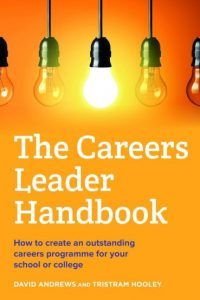
The Handbook centres on the Gatsby benchmarks, developed for use by British careers leaders. These benchmarks delineate the necessary elements of a careers program and the Handbook provides the details for implementation. The Handbook is very organized in format, as each section covers a benchmark, breaking it down into specific areas to consider or actions to take. The format makes it easy to use as a reference guide including case studies, tools, resources, links and summaries.
The suggested considerations or actions are quite practical – for example, the principles of effective employer encounters or how to work with colleagues, senior leaders or parents who have difficulty understanding the program’s fit with the curriculum. The section on Career and Labour Market Information is particularly strong, with thorough explanations on helping students learn how to research and use labour market information effectively.
- A stable careers programme
- Learning from career and labour market information
- Addressing the needs of each student
- Linking curriculum learning to careers
- Encounters with employers and employees
- Experiences of workplaces
- Encounters with further and higher education
- Personal guidance
In addition to this deep dive on each Gatsby benchmark, the Handbook emphasizes the importance of seeing the careers program as a whole, as opposed to selecting specific steps to offer while not attending to the others. The importance of hearing students’ needs and thoughts is also emphasized as an element for success.
The policies referenced are U.K.-specific, but readers can substitute their own local bodies within these references to help ensure their programming will comply with local policies. This exposure to the U.K. system and perspective is also useful for those of us not working in the U.K., as seeing the different policies and goals can expand our thinking. Depending on our location and the political will behind careers programs, we may or may not be able to enact similar programs.
One key element of a careers program, students’ self-assessment, is not emphasized as strongly and clearly as a career professional might wish. It is discussed, but is split into two sections: “Addressing the Needs of Each Student” and “Personal Guidance.” This may be due to the Gatsby benchmarks format, as these are two separate benchmarks, which each contain self-assessment elements, but the result is that it dilutes the importance and explanation of these activities. For example, “Addressing the Needs of Each Student” discusses emancipatory career guidance and ending stereotyping in work with students, and “Personal Guidance” discusses models of personal guidance. From a career counselling perspective, these concepts are both parts of self-assessment and could be discussed together in one section. Separating them does not assist a careers leader in understanding how these elements are part of one process and how they weave throughout and then unite all the careers program activities. While references for more information are included to better understand career counselling theories, the explanations in the Handbook do not give the needed level of detail regarding self-assessment. A veteran careers leader might not need this explanation, but a less-experienced leader may not understand the depth and importance of this process.
This lack of depth of how students are helped in career planning also emerges when the writers state in “Personal Guidance” that from discussions on the different roles (e.g. career advisor, career counsellor, career coach, guidance counsellor), one could conclude that these roles are all these mean “pretty much the same thing in practice” while “there are some different flavours in the way that people do it” (pg. 112). In Canada we have spent considerable time and effort to understand the differences between these roles and how each of them can specifically assist clients; perhaps this has not occurred in the U.K.
These criticisms aside, the Handbook does provide a useful guide to developing and setting up a careers program. The format enables the reader to easily reference sections and actions. The most suitable audience would be those working in the elementary and secondary school system, but as the elements of a career program are common to any career planner, this book could be useful for other organizations. Its thoroughness makes it a Handbook you may find helpful.
This article was originally published on ContactPoint on Nov. 9, 2018.





